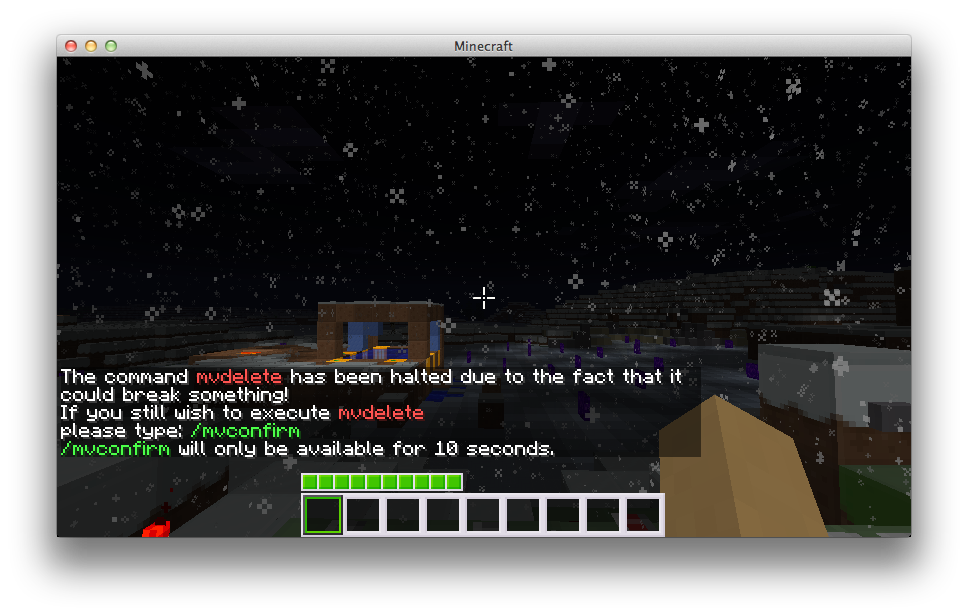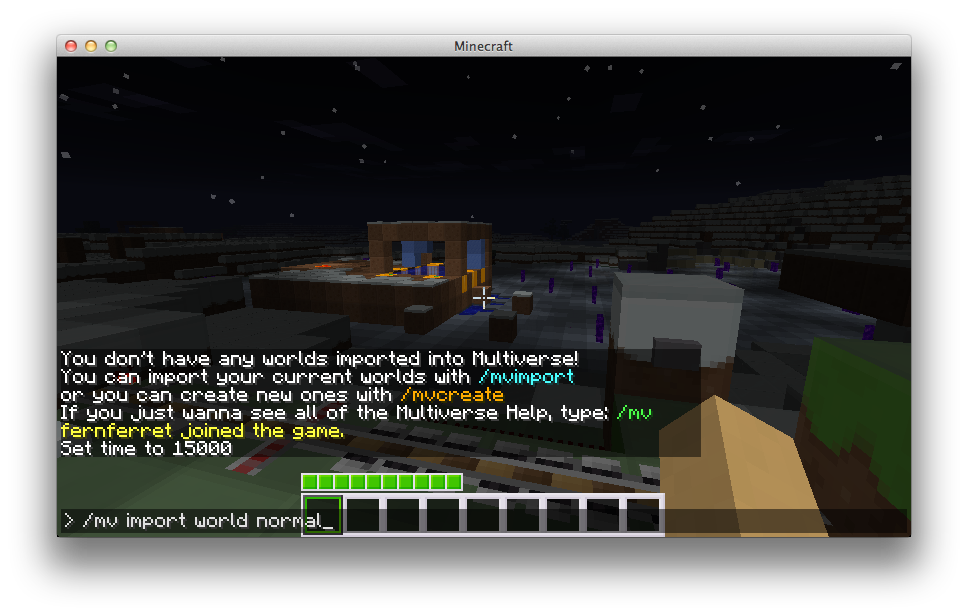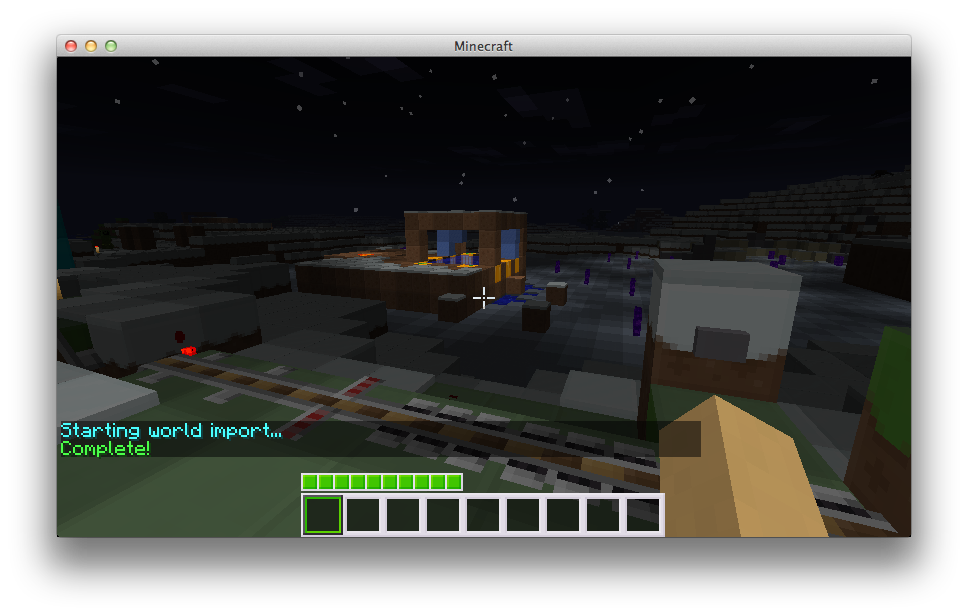Basics Usage
Introduction
World creation is provided by Multiverse-Core. It can control mob spawning, environment type, enable custom terrain generators, and much more! Despite being able to do all this, do note that Multiverse-Core does not create worlds itself, it simply makes calls to the Bukkit-API to create the worlds. If other plugins exist that create worlds, then you may have messy conflicts. Inception is a well-known example and many horror stories have been told when conflicts do happen (seemingly working fine with Multiverse-Core for some but not others). Another caveat is that Bukkit still has control over the world; Multiverse just does its best to control behavior, but ultimately, other plugins or quirks with Bukkit may possibly override desired behavior. The developers and testers have done a great job of including the tools with Multiverse-Core to help you quickly and easily resolve these issues!
Creating your first world
Let say you want a creative world! World creation is a relatively simple process. The magic invocation is as follows:
/mv create <worldname> <environment> --seed [seed] --generator [generatorname[:id]]
Don't worry about all the parameters for now, all you need to know is that any text enclosed inside <> is REQUIRED and anything enclosed inside [] is OPTIONAL.
For our example, let's simply do:
This may take a few seconds and you can see progress in your server console.
This creates a world named creative with a normal (overworld) type environment. If you are particularly clever, you could set the seed here or change the environment to nether or the_end, or if you're really clever, you can figure out how to set the generator to create all sorts of cool terrain (e.g., -g BukkitFullOfMoon). Let's not concern ourselves with that just yet.
With that invocation, your world should now be created. Horray!
Teleporting to your new world
Well now you have your world, fantastic! But... you need to get to it now, don't you? Well, that's simple too, just do:
/mv tp creativeAnd tada, you should now be in your new world! If you want to bring along a mate and he doesn't care if you teleport him all over the bloody place, just do
/mv tp <playername> creativeSetting the new world's spawn
Well let's say your new world's 0, 0 isn't exactly the most... ideal of places. You'd rather players not be dumped there when they teleport to or spawn in it! Simply walk/climb/mine to where you want your new spawn to be, and then type:
/mv setspawnIt's like magic!
Getting back to spawn
Oh no! You got lost in your world! You need to go back to spawn! Well that's pretty simple:
/mv spawnTada! Welcome home!
Modifying some parameters
Ok, so you're sick of creepers blowing your stuff up, and you want to turn off the hostiles? No problem!
/mv entity-spawn-config modify monster set spawn falseYou can change a load of other settings very easily (such as turn off animal spawning and PvP).
Purging monsters and other fun things
So you're sick of a bunch of animals getting in the way of your building. Perhaps some jackass op spawned a bunch of cows where you were building. No matter! Just clean them up with:
/mv purge-all-entities creative animalRemoving the world
You're so sick of this world! You quit! It's enough! Well, then you can nuke the world! To nuke it, just do:
/mv delete creative
You will then have 30 seconds to type:
Remember: Once you confirm your world will be completely destroyed. Gone. Not coming back. Ever. Use this command with extreme care!
/mv confirm <otp>Import existing worlds
If you have a world from another server or downloaded from the internet, you can import it into Multiverse with the following command:
/mv import <worldname> <environment>
Now, you'll have to replace <worldname> with your folder name and <environment> with the environment type. There are 3 currently available: normal, nether and the_end.

You should then see the following result:

Sweet! Now just repeat the process for all of your worlds! Don't like the folder name you have? Don't rename the folder simply set a Multiverse World Alias instead!
You must ensure that the world you are importing is generated on the same minecraft version as your server.
First Spawn Location
Multiverse allows you to set what world users will first spawn in. This does not have to be the world that is in server.properties. To do this, make sure you have the following 2 values set in your config.yml . You can set this value in-game by using /mv config first-spawn-override true and /mv config first-spawn-location myworld. We advise against editing the file, but here is the clip:
spawn:
# Sets whether Multiverse will override the first spawn location of a world.
# If enabled, Multiverse will set the first spawn location of a world to the spawn location of the world.
# If disabled, it will default to server.properties settings.
first-spawn-override: true
# Sets the world that Multiverse will use as the location for players that first join the server.
# This only applies if first-spawn-override is set to true.
first-spawn-location: ""Join Destination
Multiverse allows you to set the destination that players will always spawn in when logging in. This is useful for a hub world or similar, to enable this you need to set the the following 2 values set in your config.yml . You can set this value in-game by using /mv config enable-join-destination true and /mv config join-destination mydestination. We advise against editing the file, but here is the clip:
spawn:
# Enables join-destination below.
enable-join-destination: false
# Sets the destination that Multiverse will use to spawn players on every login
# Set the above enable-join-destination to false to disable
join-destination: ""Conclusion
Well, that's about it. Once you get curious about more advanced usage, check out both the /mv command in-game and the Command Reference .
For clarity, we have used the most verbose command names in this tutorial. To get help for a specific command simply type: /mv help and the in-game help will be shown. It should also be noted that around 90% of the Multiverse commands CAN be used from the console. Only commands that do not make sense are not supported (for example, /mv setspawn)